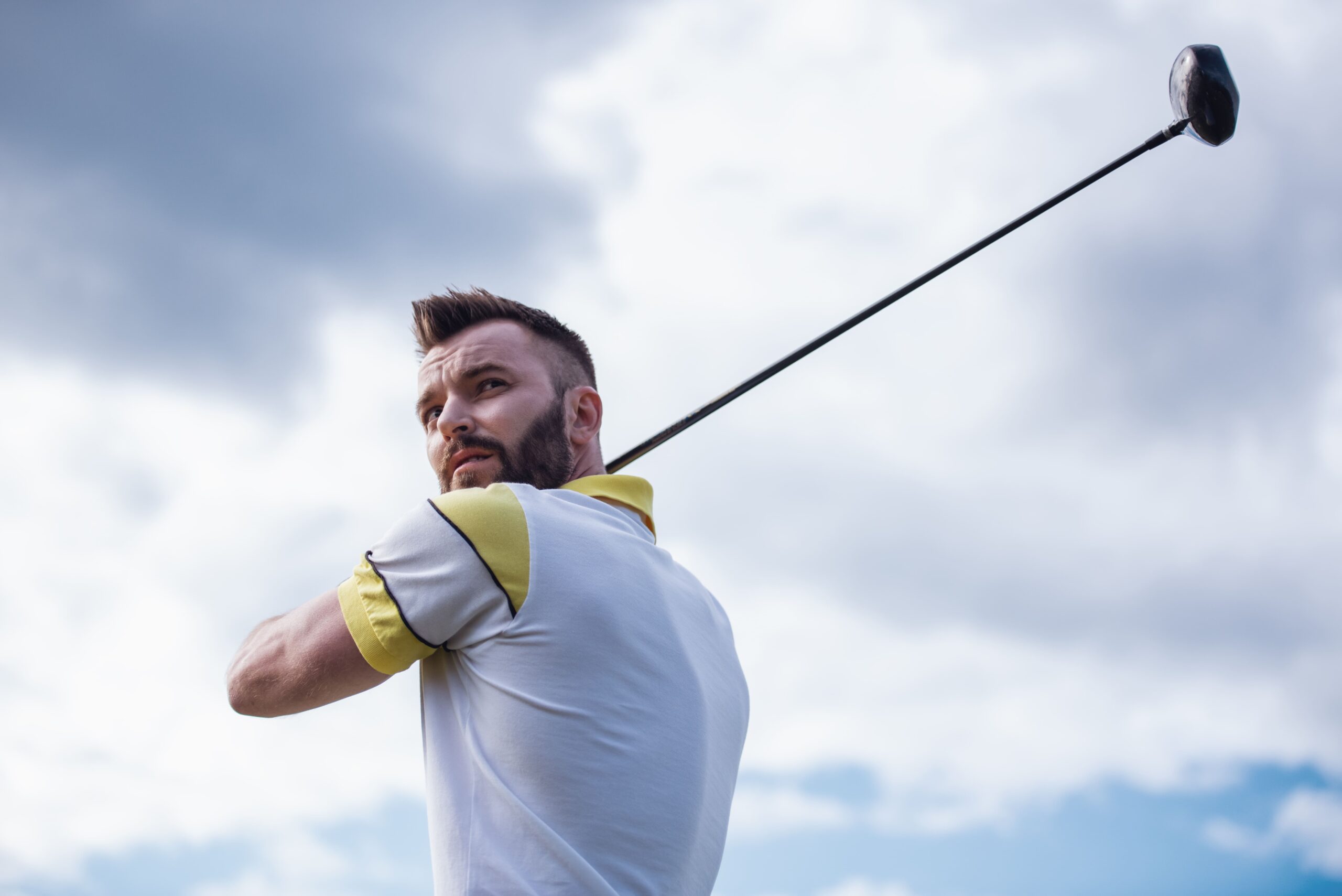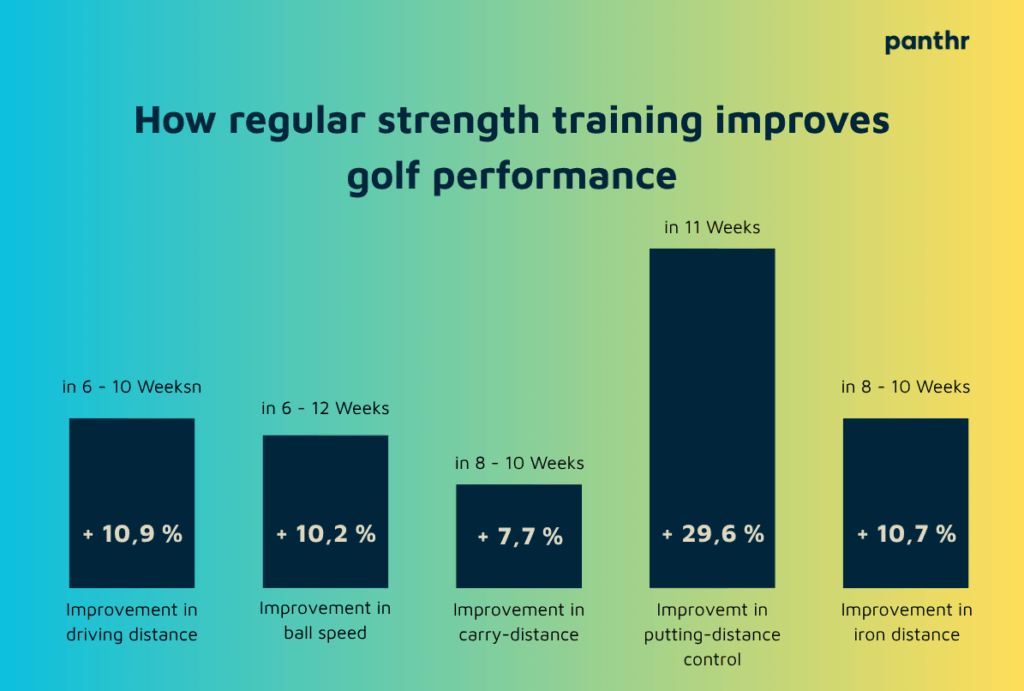Why golfers should do strength training and how

Each round of golf involves walking about 10 kilometers, and every swing engages up to 120 muscles. It’s clear: Golf and strength training are inseparable. They optimize your swing and make you stronger on the fairway.
Why Golf and Strength Training?
More distance, greater control, fewer injuries—these are the top reasons why golfers should incorporate strength training into their routine. Studies show impressive performance gains through strength training: You can increase your driving distance by 11% in just 8 weeks, and your clubhead speed—crucial for distance and ball flight—can improve by up to 6.3% in 6 to 12 weeks. Strength training boosts the explosive power of key muscle groups for the swing, enhancing neuromuscular coordination. In simple terms, you’ll swing more efficiently with less effort.
Golf, Strength Training, and Injury Prevention
In addition to improving performance, strength training significantly reduces the risk of injuries. Though non-contact, the repetitive and one-sided nature of golf can lead to overuse injuries. Around 40% of amateur golfers and 60% of professionals experience injuries at least once per season. The primary cause is the high torsional forces during the swing. A well-conditioned body can better handle these stresses. Strength training fortifies muscles, tendons, and ligaments, stabilizes joints and the spine, and significantly lowers the risk of golf-related injuries. Studies show a nearly 50% reduction in overuse injuries. Additionally, stronger golfers fatigue more slowly during their rounds, maintaining better stability in their swing and posture, even on the final holes, improving consistency.
Strength Training and the Mental Component
Strength training also has a positive impact on the mental side of golf. When you feel stronger and more resilient, you approach the game with greater confidence. Knowing you’re physically prepared can boost motivation and improve concentration. Ultimately, strength training makes you more stable and resistant to injury—two key factors for taking your game to the next level.
Which Muscles Are Involved?
A successful golf swing is a complex full-body movement. Many muscles are involved, but some play a particularly vital role. Scientific analyses of the golf swing show that the gluteus maximus (buttocks) is the “motor” of the lower body. It drives hip rotation during both the backswing and follow-through, helping you maintain a powerful, balanced finish.
In the upper body, the chest muscles (pectoralis major), latissimus dorsi (broad back muscles), and shoulders play a key role. These muscles explosively move the arms in front of the body and downward during the downswing and impact, facilitating the transfer of power to the ball. Essential is the core, especially the abdominal and lower back muscles. They form a stable connection between the lower and upper body, transferring the power of the legs into the upper body and the club. A strong core enables controlled rotation and protects the spine.
And, of course, the forearm and wrist muscles are crucial. They grip the club and transfer all the energy generated by the body to the clubhead at impact. A firm grip and strong forearms help maintain clubhead speed and keep the clubface stable. Studies even show that grip strength is positively correlated with driving distance—so working on your forearms can increase your distance.

Muscular Imbalances in Golf
Due to the repetitive movement pattern in golf—almost all players swing on the same side—the risk of muscular imbalances is significant. “Dysbalance” refers to uneven muscle development on one side of the body. Golfers tend to develop stronger and more flexible muscles on their dominant side while neglecting the non-dominant side. Over time, this can lead to imbalances between the left and right sides of the body or between pulling and pushing muscles.
The Consequences of Muscular Imbalances
The consequences of muscular imbalances are far-reaching. They can affect swing mechanics: Different mobility in the shoulders or hips can lead to an asymmetrical swing. The technique suffers, causing an uneven backswing or an incomplete follow-through. Furthermore, the risk of injury significantly increases. When one muscle group is overdeveloped and its antagonist is too weak, improper loading occurs. For example, many right-handed golfers have a dominant right chest and shoulder, while the left side is weaker. This can lead to shoulder issues or spinal misalignments. Differences in trunk muscles between the left and right sides are also risky, as they lead to one-sided strain on the back.
Studies show that muscular imbalances and the resulting overuse injuries are among the most common causes of golf-related injuries, such as chronic lower back pain, wrist problems, or golfer’s elbow. These injuries develop gradually due to repetitive stress on specific structures. Shoulder and knee issues can also arise from muscular imbalances, such as weak rotator cuffs or imbalanced leg muscles.
Preventing and Correcting Dysbalances
The good news is that muscular imbalances can be addressed through targeted training. The key is “counterbalance training”—exercises that aim to restore symmetry by strengthening the non-dominant side and neglected muscles. This is particularly effective with unilateral exercises—those that work one side of the body at a time. Examples include lunges, single-arm shoulder presses, and single-arm rowing. By starting with the weaker side, you ensure balanced loading of both sides. Unilateral training helps to correct strength differences and also improves coordination and stability on each side.
Training with the Weaker Side
It’s common among top golfers to practice with their non-dominant side. Research suggests that practicing counter swings can improve technique on the dominant side. The authors believe that training the non-dominant side can increase clubhead speed on the dominant side and reduce imbalances and pain. Though this research is still in its early stages, it makes sense: Training both rotational directions creates a more balanced muscular and neural system, benefiting the primary swing side as well.
In another study, elite golfers trained their core exclusively for eight weeks, increasing their driving distance by about 5%. A second group added targeted training of the non-dominant arm, improving their driving distance by an average of 10.9% – almost twice as much. This highlights how much potential lies in strengthening the “neglected” side!
Golf and Strength Training – Frequency, Structure, Content
When designing a strength program for golfers, it’s important to take a balanced approach that fits well into your golf routine. Here are key points about training frequency, structure, and content:
Golf and Strength Training – Exercise Examples
Training Volume and Intensity
Strength Training at Home
You don’t need a gym to train effectively. Dumbbells, resistance bands, and bodyweight exercises can provide a great workout. Consider adding a cable station or barbell set as you progress. Exercises like push-ups, squats, lunges, dips, and planks can be done anywhere. Resistance bands and dumbbells offer versatile options for a full-body workout. Always focus on clean technique, especially if you’re training without supervision.